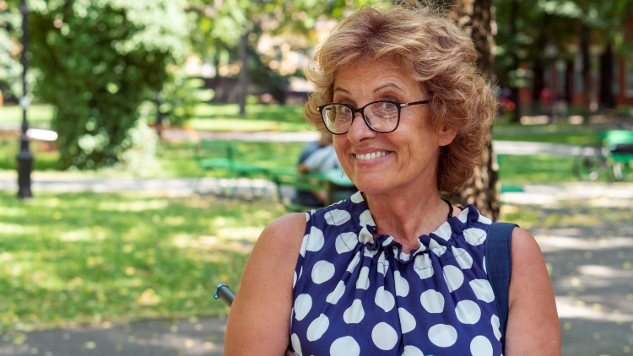
In This Article
- Is chronic inflammation really inevitable as we age?
- Why do Indigenous communities escape the inflammation trap?
- How does modern stress fuel premature aging?
- What can we learn from Blue Zone lifestyles?
- Which habits reduce inflammation without medication?
Retire or Expire? Why Modern Life Makes You Old Before Your Time
by Robert Jennings, InnerSelf.comThe idea that inflammation worsens with age has been repeated so often that it’s practically a mantra in Western medicine. It’s the “gray tax” we’re told to accept—an invisible but steady drip of cytokines wearing down the immune system, the heart, the brain, and everything in between. Chronic inflammation has been blamed for everything from Alzheimer’s to arthritis to heart disease. Doctors measure it, drug companies profit from it, and most people accept it as the cost of growing old in the modern world.
A massive international study, conducted by a team of researchers from various disciplines and institutions, has just shown that this pattern doesn’t exist in Indigenous populations in Malaysia and Bolivia. Not even a little. These communities—living without air conditioning, ultra-processed food, or constant digital distractions—simply don’t exhibit the same age-related rise in inflammation.
Let that sink in. It’s not aging that causes inflammation—it’s how we age. Or more precisely, how we live while we age. The real culprit isn’t time—it’s lifestyle. And the systems we’ve built around that lifestyle. When stress, loneliness, poor sleep, and sedentary habits become normal, it’s no surprise the immune system goes haywire. We’ve mistaken a cultural disease for a biological destiny. However, suppose inflammation isn’t a hardwired part of the aging process. In that case, it can be rewired by changing the way we live, connect, and care for one another. That’s not just hopeful. It’s revolutionary.
A Study That Pulls Back the Curtain
Researchers studied nearly 3,000 adults across four countries: Italy, Singapore, Bolivia, and Malaysia. The two industrialized nations—Italy and Singapore—delivered results that perfectly aligned with the Western narrative: inflammation levels steadily rose with age, and that rise was tightly linked to chronic diseases like kidney dysfunction and cardiovascular decline. This confirmed what many in the medical establishment already believed—that inflammation is a biological inevitability, a gradual consequence of aging.
In the Indigenous Tsimane people of Bolivia and the Orang Asli of Malaysia, inflammation told a completely different story. It didn’t increase with age. It wasn’t associated with chronic illness. In fact, the elders in these communities seemed almost untouched by the inflammatory wear and tear we now accept as just part of the aging process.
This wasn't a minor discrepancy. It was a scientific shockwave. How could two vastly different outcomes emerge from the same biological process, unless the process itself isn’t universal? That leads us to the billion-dollar question: what’s the difference? If inflammation doesn’t rise with age in these Indigenous groups, but does in industrialized populations, then something about the environment—not the biology—is driving the change. And if that’s true, then maybe aging as we know it isn’t broken biology at all. Maybe it’s a culture-induced condition masquerading as fate.
Welcome to the Stress Olympics
If you live in a modern industrialized society, you’re competing every day in the Stress Olympics. Not by choice—just by waking up. You race the clock, chase money, dodge traffic, multitask through digital pings, and scroll through bad news on a glowing screen before bed. Then you wonder why you can’t sleep, why your joints ache, why your mind feels foggy, and your gut feels like it’s plotting against you. It’s not subtle. It’s systemic.
Modern life manufactures stress. And stress, in turn, manufactures inflammation. The biological mechanism is straightforward: the body responds to chronic stress by releasing cortisol, which, over time, loses its suppressive effect on inflammatory cytokines. The result? A constant, low-grade immune overdrive. Your body’s alarm system never shuts off. And like any alarm that blares too long, it begins to damage the house it was meant to protect.
Blue Zones and the Inflammation Paradox
Want another clue that industrial life is the real culprit behind chronic inflammation? Just look at the Blue Zones—those rare regions around the globe where people live significantly longer and healthier lives than the rest of us. These areas, identified by National Geographic explorer Dan Buettner, include Sardinia in Italy, Ikaria in Greece, Okinawa in Japan, Nicoya in Costa Rica, and even Loma Linda, California. These communities don’t rely on the latest pharmaceutical breakthroughs or anti-aging biohacks. They eat mostly natural, unprocessed food grown locally. They move often—but not in gyms—through daily chores, walking, farming, or tending to animals. They sleep in sync with the natural light cycle. And perhaps most importantly, they are embedded in strong, intergenerational social networks. Could lack of Inflammation, as we’ve come to know it, simply doesn’t dominate their lives.
These aren't wellness influencers or Silicon Valley tech bros chasing longevity—they’re farmers, teachers, grandparents, and neighbors. The elders in Okinawa aren’t juggling five prescriptions. They’re tending gardens and practicing tai chi. The women in Sardinia aren’t withering away in air-conditioned solitude. They’re preparing meals for extended family, laughing and gossiping with friends. In Nicoya, centenarians walk to the market daily, not because it’s a trendy health habit, but because that’s just the way life is. And that life—grounded, connected, slow but purposeful—seems to shield them from the inflammatory breakdown we’ve normalized in the industrialized West.
Aging in these places doesn’t look like slow decay. It looks like a graceful transition. The body slows down, yes, but the spirit stays rooted. There’s no frantic battle to "fight" aging, no endless stream of miracle pills, no multi-billion-dollar longevity industry pushing products to fix what our culture broke in the first place. Blue Zones offer living proof that aging can be healthy, dignified, and inflammation-free—when you build a life that honors rhythm, community, and meaning instead of one built around speed, stress, and screens. Their longevity isn't a mystery—it's a consequence of living human lives in human ways.
The Industrial Feedback Loop
Chronic inflammation isn’t just a byproduct of modern life—it’s a vicious feedback loop that feeds on itself. Stress triggers the release of inflammatory cytokines. Those inflammatory messengers then contribute to symptoms like fatigue, joint pain, brain fog, depression, and blood sugar instability. And what do most people do when they feel like that? They sit more, move less, snack on ultra-processed comfort foods, sleep poorly, and become increasingly irritable. Each of these behaviors further inflames the body, keeping the cycle going like a machine with no off switch. The tragedy is that we've normalized this. We’ve built a society that creates illness and then monetizes it, offering pharmaceuticals and quick fixes for symptoms while leaving the deeper dysfunctions of our lifestyle, our pace, and our disconnection unaddressed.
And it’s not just the physical stuff that fuels the fire. Even the subtler, “invisible” pressures—such as loneliness, social isolation, job insecurity, and a lack of purpose—can trigger a biological stress response. The science is precise: chronic social disconnection elevates inflammatory markers just as surely as smoking or a poor diet. Humans didn’t evolve to live as isolated individuals in apartment boxes, staring at screens and wondering why we feel off. We’re tribal by nature—wired to live in cooperative groups with shared rhythms and roles. When you take that away, it’s not just the soul that suffers. The immune system falters, too. In the name of progress, we’ve stripped away the very things that made us resilient, and inflammation is the body’s way of waving a red flag.
How to Get Off the Conveyor Belt
So what can we do? Luckily, you don’t need to move to the jungle or grow a hundred-year-old olive tree to reclaim your biology. You can start now:
1. Eat like you live on an island. Ditch processed food. Go for whole plants, nuts, fish, olive oil, and spices like turmeric. Your gut microbiome—and your cytokines—will thank you.
2. Move daily, but gently. Walk. Stretch. Garden. You don’t need CrossFit, you need consistency.
3. Prioritize sleep like your brain depends on it—because it does. No screen time at night. Embrace darkness.
4. Find your people. Call a friend. Join a group. Share meals. Isolation is more inflammatory than sugar.
5. Have a reason to get up in the morning. Whether it’s gardening, mentoring, or volunteering, purpose is the most potent anti-aging drug we have.
And yes, supplements like curcumin, probiotics, and omega-3 fatty acids can help. But they’re no substitute for living in a way that doesn’t set your body on fire in the first place.
Rethinking the Myth of Aging
It’s time to stop blaming age itself for decline. The problem isn’t the number of candles on the cake—it’s the way we’ve been conditioned to age in a world built for profit, not people. In industrialized societies, we’re expected to spend our prime years confined to cubicles, trapped in traffic, numbed by screens, and hooked into a healthcare system that manages symptoms but rarely questions their causes. We’re funneled into a life that equates aging with irrelevance, dependency, and degeneration. The result? We’ve industrialized not just our economies but our very life cycle, turning what could be a time of reflection, purpose, and interconnection into a slow disintegration of body and spirit.
It’s no surprise, then, that so many people in industrialized countries dream of escaping when they retire. They long to move to the countryside, to the coast, to a quiet village—or even abroad—to places where the pace slows down and life feels more human again. What they’re really yearning for isn’t just scenery or sunshine. They’re seeking connection, simplicity, and a reprieve from the relentless grind that’s been inflaming them for decades. Retirement fantasies are often less about leisure and more about liberation from stress, isolation, processed living, and medicalized aging. But why wait until 65 to live like your body and soul matter? Aging doesn’t have to be a story of slow collapse. It can be a celebration of wisdom, vitality, and meaningful connection—if we choose to live as if it matters, long before the retirement brochures arrive in the mailbox.
About the Author
 Robert Jennings is the co-publisher of InnerSelf.com, a platform dedicated to empowering individuals and fostering a more connected, equitable world. A veteran of the U.S. Marine Corps and the U.S. Army, Robert draws on his diverse life experiences, from working in real estate and construction to building InnerSelf with his wife, Marie T. Russell, to bring a practical, grounded perspective to life’s challenges. Founded in 1996, InnerSelf.com shares insights to help people make informed, meaningful choices for themselves and the planet. More than 30 years later, InnerSelf continues to inspire clarity and empowerment.
Robert Jennings is the co-publisher of InnerSelf.com, a platform dedicated to empowering individuals and fostering a more connected, equitable world. A veteran of the U.S. Marine Corps and the U.S. Army, Robert draws on his diverse life experiences, from working in real estate and construction to building InnerSelf with his wife, Marie T. Russell, to bring a practical, grounded perspective to life’s challenges. Founded in 1996, InnerSelf.com shares insights to help people make informed, meaningful choices for themselves and the planet. More than 30 years later, InnerSelf continues to inspire clarity and empowerment.
Creative Commons 4.0
This article is licensed under a Creative Commons Attribution-Share Alike 4.0 License. Attribute the author Robert Jennings, InnerSelf.com. Link back to the article This article originally appeared on InnerSelf.com
books_health
Article Recap
Chronic inflammation is not an unavoidable part of aging—it’s a symptom of how we live. Studies of Indigenous tribes and Blue Zones show that healthy aging comes from community, movement, natural diets, and low chronic stress. Understanding these factors can help us rewrite the aging script in modern society.
#ChronicInflammation #HealthyAging #BlueZones #AntiInflammatory #Inflammaging #ModernStress #IndigenousWisdom #LongevitySecrets



